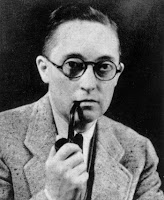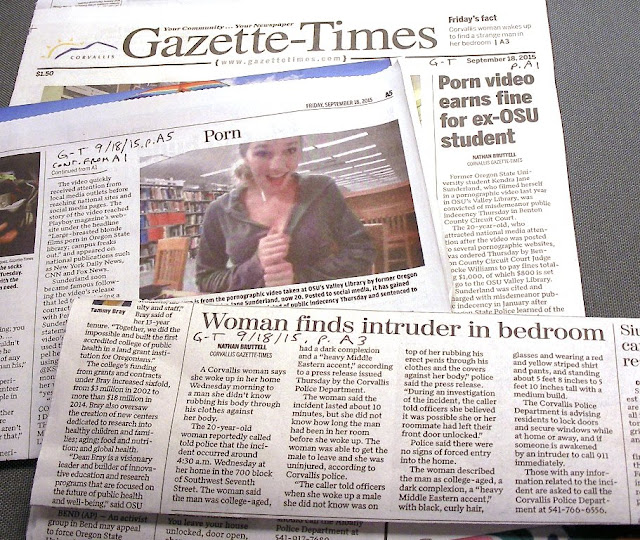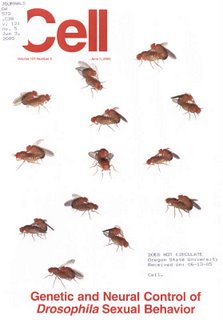
PHOTO: A newspaper headline from 1974 reports Hewlett-Packard's plans to build a calculator plant and research facility in Corvallis as described in the newspaper article by John Atkins, "H-P executive predicts 700 new jobs," Gazette-Times Aug. 8, 1974, p. 2. (See previous posts Don't Cali-fornicate Oregon and HP annexation history (6/14/12) and HP and Corvallis newspaper history (3/11/09) about the move of the Hewlett-Packard calculator division to Corvallis in 1975)
UPDATE 9/16/15): My local newspaper reporter called me and also received the official word from an HP press person: See "HP to jettison up to 30,000 jobs as part of spinoff," gazettetimes.com posted Sep. 16, 2015
"Hewlett-Packard Co. is preparing to shed up to another 30,000 jobs, but officials said the cuts should not affect the company's Corvallis campus. . . Currently, the Corvallis site is used in the development of new printing and imaging technologies and in value-added processing of silicon wafers. The Corvallis site will primarily be an HP Inc. site after the planned separation next month, said Blair J. Hinderliter, HP media relations representative in Palo Alto, California. . . Hewlett-Packard employs an estimated 1,800 people at its 140-acre Corvallis campus on Northeast Circle Boulevard (the company does not release local employee numbers). The Corvallis site employed around 10,000 people at its peak in 1996. But, since then, the number has dropped. By 2012, the number had fallen to about 2,000 employees in 2012, according to previous reports. . ." (Quoted from "HP to jettison up to 30,000 jobs as part of spinoff," gazettetimes.com posted Sep. 16, 2015)
The moneymen of Wall Street, mostly for their own profit, persuaded HP to split up, supposedly so company mangers could better "focus." As part of the split-up process, I recently received a legal letter in the mail describing how the health and retirement benefits, which were promised to me decades ago, will he transferred to be the sole responsibility of the new HP Inc. instead of the original, larger and more diversified company. In my view, this change only benefits Wall Street, because HP has always been able to "focus" more than required to mange their diverse business portfolio. The split-up only shifts financial risk to HP employees and retirees, which prompted me to write the following letter to the editor of my local newspaper serving my town whose economy is dominated by HP and OSU employees: (Note: below is the text of my letter as I submitted it -- the printed version was edited to meet the Associated Press style that uses a hyphen in HP, unlike what the company's and what most other editors' style sheets specify.)
For nearly 40 years, Corvallis has benefited from the presence of Hewlett-Packard, which recently split into four separate companies (HP Inc., Hewlett-Packard Enterprise, Agilent Technologies and Keysight Technologies) largely at the urging of Wall Street investors.
The HP Corvallis site was nurtured for more than a decade by John Young, a 1954 Oregon State University electrical engineering alumnus, after he became the first non-founder CEO of HP.
The HP Corvallis division evolved from building the world's first programmable handheld computers, to portable computers and battery-operable inkjet printers, all of which naturally worked with the electronic test and measurement instruments famously made by HP since its founding.
I am sure the company founders Bill Hewlett (1913-2001) and Dave Packard (1912-1996) are spinning in their graves over HP breaking up, based on what I learned while traveling with Bill and Dave to division management reviews in their private jet that they insisted on having all empty seats filled by regular HP employees.
The HP breakup could hurt the Corvallis economy because many promised employee benefits, including healthcare, for both current and retired HP employees are now tied to only HP Inc. instead of the original, larger and more diversified HP as Bill and Dave intended.
Unfortunately, HP beneficiaries can diversify only some, but not all, of their benefits and retirement accounts.
The only thing Corvallis can do now is to pray for the success of both HP and OSU.
(Quoted from Thomas Kraemer, "HP breakup could harm economy," Gazette-Times, Sep. 11, 2015, p. A9)
(Note the above text is as I submitted the letter, which the newspaper edited to meet their Associated Press style that abbreviates Hewlett-Packard as H-P (with a hyphen) instead of without a hyphen as the company and most other editors prefer to do it.)
About a year ago, my local newspaper printed the "Editorial: HP's split raises vital questions for the mid-valley," gazettetimes.com posted Oct. 8, 2014. It said in part, "We've learned that lesson the hard way, as employment at the HP campus in Corvallis tumbled from more than 7,000 back in the days when the company did high-volume manufacturing of inkjet printer cartridges at the site down to an estimated 1,800 today. . . ."
The official corporate press release predicted correctly the split would be finished by Nov. 1, 2015: "HP To Separate Into Two New Industry-Leading Public Companies," hp.com posted Oct. 6, 2014, which was reported by the more recent news story by Anita Balakrishnan, "HP announces post-split boards," cnbc.com posted Aug. 12, 2015
For a good history of HP electronic test and measurement instruments business, see the official "Keysight Technologies History," keysight.com accessed Sep. 8, 2015. Interestingly, it appears that the only part of HP Labs that survived the split-ups is the part I managed in the 1980's for advanced test and measurement research. This research included the invention of the software object-oriented programming system adopted by Apple Computer. (See the blog post by Don Tuite, "Agilent T&M becomes Keysight; the Old HP Labs Keep the Agilent Name," electronicdesign.com posted Aug 2, 2014 and my previous post Apple Apps written in Objective-C can now use 'Swift' language (6/17/15)) The reason this is the only part of HP Labs that survived is probably because the printer group formed its own advanced research lab in Corvallis and in my experience most of the rest of HP wasn't interested in the work HP labs had been doing. For example, the Corvallis division until the early 1980's ignored much of the work HP Labs did with Stanford and Xerox PARC researchers who invented the modern concept of personal computer interfaces that are embodied in Microsoft Windows and modern smartphone interfaces, such as Android and Apple iPhones. (See Apple Apps written in Objective-C can now use 'Swift' language (6/17/15))
Of a loosely related interest is the local Corvallis newspaper story about one of the farms that is nearby the HP Corvallis campus: Bennett Hall, "History is a living thing for fifth-generation Corvallis farmer Kenny Reynolds,"Gazette-Times, Sep. 8, 2015, p. A1
 PHOTO: Alan L. Hart, shown in 1943, grew up in Albany, Oregon (across the river from Corvallis, Oregon State University) as Alberta Lucille Hart and is considered to be an early example of an FTM or female-to-male. Early gay historians controversially categorized Hart as a lesbian instead of transgendered or other category. Even earlier, many people thought that women would dress as men to obtain male privileges common before the 1960's women's liberation movement started. (See previous posts Oregon FTM doctor's 1925 marriage and Baker case recalled by Portland gay newspaper (7/23/15), Albany, Oregon FTM Alan Hart 1890-1962 (9/3/11), Jonathan Ned Katz gay history pioneer (3/6/10) and Alan L. Hart (Wikipedia))
PHOTO: Alan L. Hart, shown in 1943, grew up in Albany, Oregon (across the river from Corvallis, Oregon State University) as Alberta Lucille Hart and is considered to be an early example of an FTM or female-to-male. Early gay historians controversially categorized Hart as a lesbian instead of transgendered or other category. Even earlier, many people thought that women would dress as men to obtain male privileges common before the 1960's women's liberation movement started. (See previous posts Oregon FTM doctor's 1925 marriage and Baker case recalled by Portland gay newspaper (7/23/15), Albany, Oregon FTM Alan Hart 1890-1962 (9/3/11), Jonathan Ned Katz gay history pioneer (3/6/10) and Alan L. Hart (Wikipedia)) 








